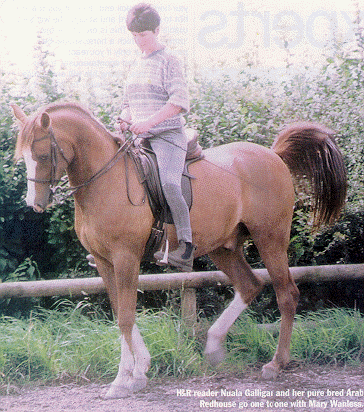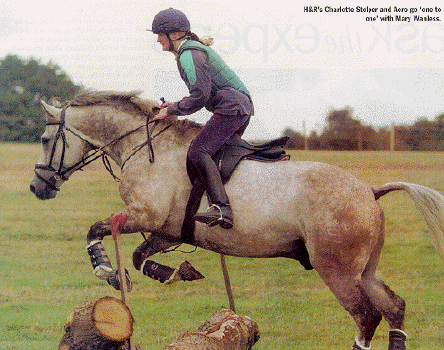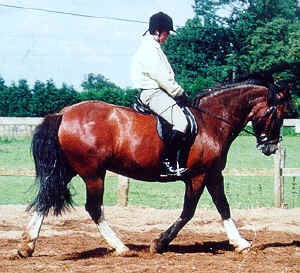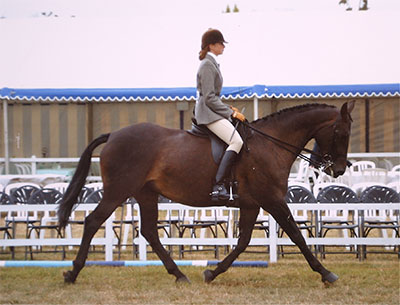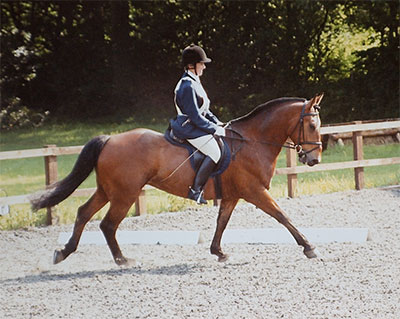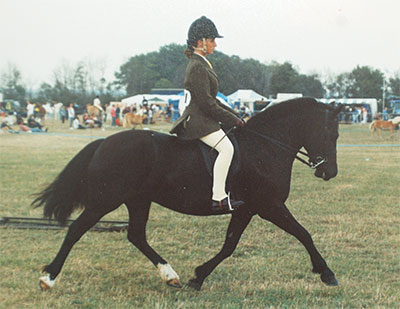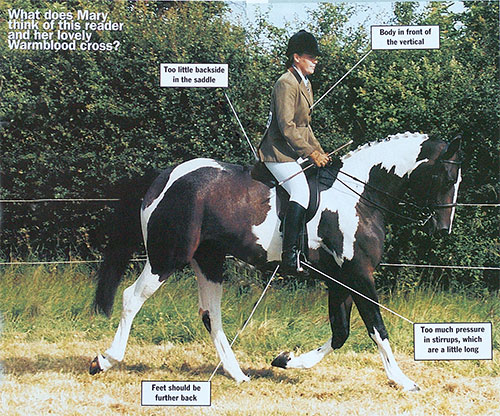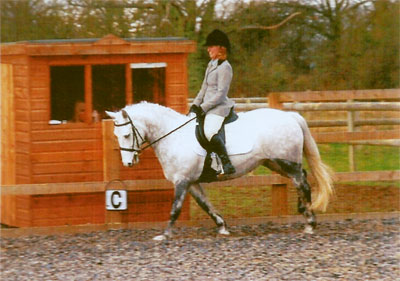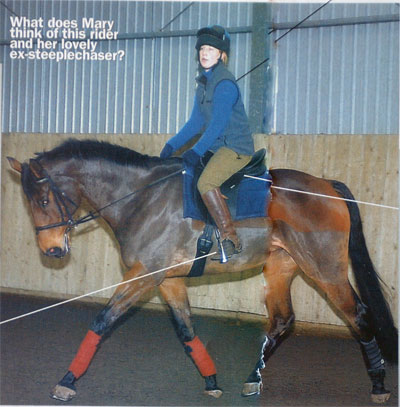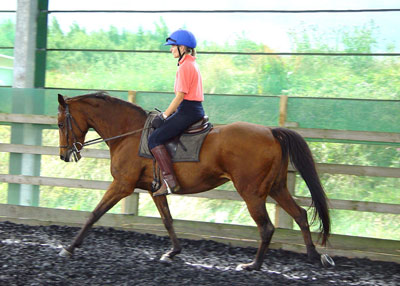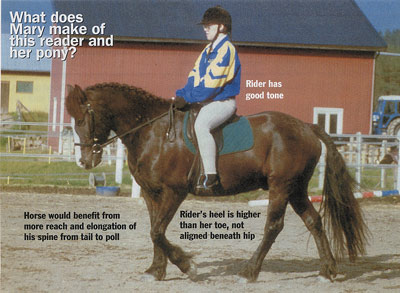RWYM
ARTICLE 27


The right photograph was the one used to write the article. Since we have lost the original the reproduction here is not good quality; hence to the left is another photograph taken during the same clinic.
The horse pictured here is Rambo, a seventeen year old Danish warmblood stallion, whose name may be familiar to some readers. Thanks to the wonders of artificial insemination, he has sired many foals in mainland Europe, the UK and the USA. As a young horse in the stallion grading the Denmark he did incredibly well, and he was reserve for the Danish Olympic team at the Sydney Games in 2000, then ridden by Leif Soerensen. He is so compact and beautifully proportioned that he reminds me of a larger version of an Iberian horse.
His American owner brought him home to the USA in late 2000, where Heather Blitz, who is pictured here, took over the ride on him. She is now ranked 10th of the American grand prix dressage riders, and I am proud to be able to list her as one of the really good riders I have helped. This photograph was taken during a lesson I taught in May.
I first began teaching Heather rider biomechanics in 1994 on her previous horse, who just reached Grand Prix level before he retired to an easier life. Our first meeting was at a teacher training course held in America. One of Heather’s particularly enterprising pupils had read my books and known exactly how she wanted to be taught, so she had arranged for a group of them to club together and send Heather to me. By the time I met the group a year later, Heather had indeed done a good job with their alignment, rising trot mechanism, and other basics. But she had not done such a good job with herself.
Although it was clear from the start that she had the potential to be a top class rider, she was doing a lot wrong. We chuckled later about how, even though her pupils had learnt how to drop their ribs down towards their hips and get the correct angles in their joints, Heather was still growing too tall and riding with her stirrups too long. It took some doing to convince her that she should change this.
She later admitted to me that the shape I put her into felt so weird and wrong that she thought ‘I’ll just humour her for a while, and then she’ll forget about it.’ But she had underestimated my tenaciousness, and I stayed ‘on task’ until the changes in her horse convinced her that the change in her was truly worthwhile. She also later admitted that she had been ‘lecturing all my pupils on the need to go for these weird new feelings, whilst there I was, not willing go for it myself…’
The Heather that you see here is the ‘squished’ version that long ago became her new norm. Look at the line of her back, where you see a slight forward curve at her waist, a slight backward curve in her rib cage, and a slight forward curve to the neck. But these curves are in balance, with no one of them more exaggerated than the others. If we could press down on her shoulders, the line of force would go directly down to her seat bones. This is rarely the case, for the hollow backed rider would deform and hollow more in response to that push, whilst the round backed rider would be come more rounded.
Notice too the angles of her joints. She is pictured here riding passage, so she can perhaps be forgiven for having lifted her knee and heel just a fraction. If they were in their ideal places, just a little more down and back, her angles would be spot on, with the thigh at 45 degrees to the ground. Her ear, shoulder, and hip are perfectly aligned, whilst her heel is slightly forward of the ideal that would have her land on the riding arena on her feet if her horse were taken out from under her by magic.
Most of you reading this would, I imagine, realise that you are looking here at an unusually good rider. But do you know what it is that tells you this? I ask because I can assure you that I if sculpted your body into the same alignment, most of you would have a heart attack. For instance, the vast majority of aspiring dressage riders would have to put their stirrups up to match the angles that Heather has here. Look again at the angle of her thigh. Are you trying to make yours vertical? Are you trying to get your lower leg ‘on the girth’? Even though Heather’s foot has come forward slightly, it is not ‘on the girth’. Are you trying to take your thigh off the saddle, and to get your calf against the horse? Heather has her thigh against the saddle, and her calf close to the horse but not on it. She (and other top class riders) are defying the myths that many people swear by.
One truth that she demonstrates very well is the straight line from the elbow, down the lower arm and rein to the bit. The arms clearly just hang from the shoulder, as if the shoulders and elbows were held down by weights, and they have almost a 90 degree bend at the elbow. Many riders have ‘ballet arms’, where the whole arm appears to curve, and others have straight elbows and a much lower hand that is desperately trying to get the horse’s head down. Heather’s hands are out in front of the saddle pad, with the thumb on the top, and as if there were no wrist. The back of the hand is like a straight on continuation of the arm. You only have to put your arms out in front of you like this, and then move your wrists to appreciate that there are many variations on the theme, all seen much more commonly than this.
There is a fine line between limp arms, heavy unsupported arms, wobbly arms, pulling arms, and arms where the hands could ‘push a baby buggy’. The test for the later is that if we cut the reins, the rider – like Heather – clearly would not budge. Her contact on the curb rein is slightly stronger than is ideal, but still there is no pull back. The bit is functioning like the lid on the end of a toothpaste tube, stopping the toothpaste from leaking out. Rambo is clearly more full of ‘toothpaste’ than the average horse. Part of this is his stallion-ness, and much more than you might imagine comes down to sheer good riding.
One critical factor in Heather’s skill is that her body only moves at the joints, and the sections between the joints remain stable. Think in contrast of backs that wiggle in the middle, or of wiggly legs and arms. It sounds far to simplistic to be true, but one test of a rider’s skill is whether you can superimpose a stick figure on her body. This stick-figure-shape is so obvious with Heather, but try this test with the rider in last month’s article, and with people you see around you. You will discover that stick-figure-ness is a very rare quality, that brings with it the wonderfully uncluttered look that typifies a really good rider’s body.
What we are seeing here is the absence of excess tension, and some of the ‘clutter’ that besets most of us is the tension through which we defy gravity, lifting shoulders and arms (for instance). Yet more ‘clutter’ comes in the lack of tension that makes us wobble in places where we shouldn’t, and very few riders can combine the ideal of firmness in the muscles with yielding in the joints. Another helpful comparison is to a stuffed toy rider, and most of us have soggy places, running out of stuffing (for instance) down towards our feet. But Heather’s body is like a brand new stuffed toy, evenly and firmly filled. This gives her a stability and solidity which few riders have naturally, but which we can all learn to imitate.
This ‘stuffing’ is the source of the tone and power that enables the rider to stay ‘with’ the horse, without cramping his style. Imagine bouncing along on a very bouncy space-hopper. (Passage, believe me, is very bouncy!) You have to stay ‘with’ both the up-and-down, and the forward movement. Heather is neither left behind, nor hanging onto the reins to save herself, nor trying to spare herself by limiting the amount that he bounces. Not only can she stay with the ‘bounce’, she can encourage him to bounce even better!
Notice too that Rambo’s nose is in front of vertical, and if it were not for his enormous crest, his poll would be the highest point of his neck. This column has featured horse after horse that is overbent, with noses behind vertical and necks that do not curve evenly from wither to poll. The novice horse would be less ‘stuffed’ and less ‘up’, but he should show a far more similar profile than most do. It is the mechanics of the rider’s sitting which creates this, so the task that faces all of us is to work out how to make our body function like Heather’s. Once we have done this, we have worked out how to ride.
Even Heather is not quite using the minimum number of muscles to the maximum advantage – if you look carefully, you can see that the muscles each side of her neck are bulging out, showing that they too have become involved in the effort of sitting to passage. Ideally they would not have joined in. In truth, we are all homing in on a mythical ideal, and even the best riders hit it only some of the time. But what you are seeing here is pretty damn close!


